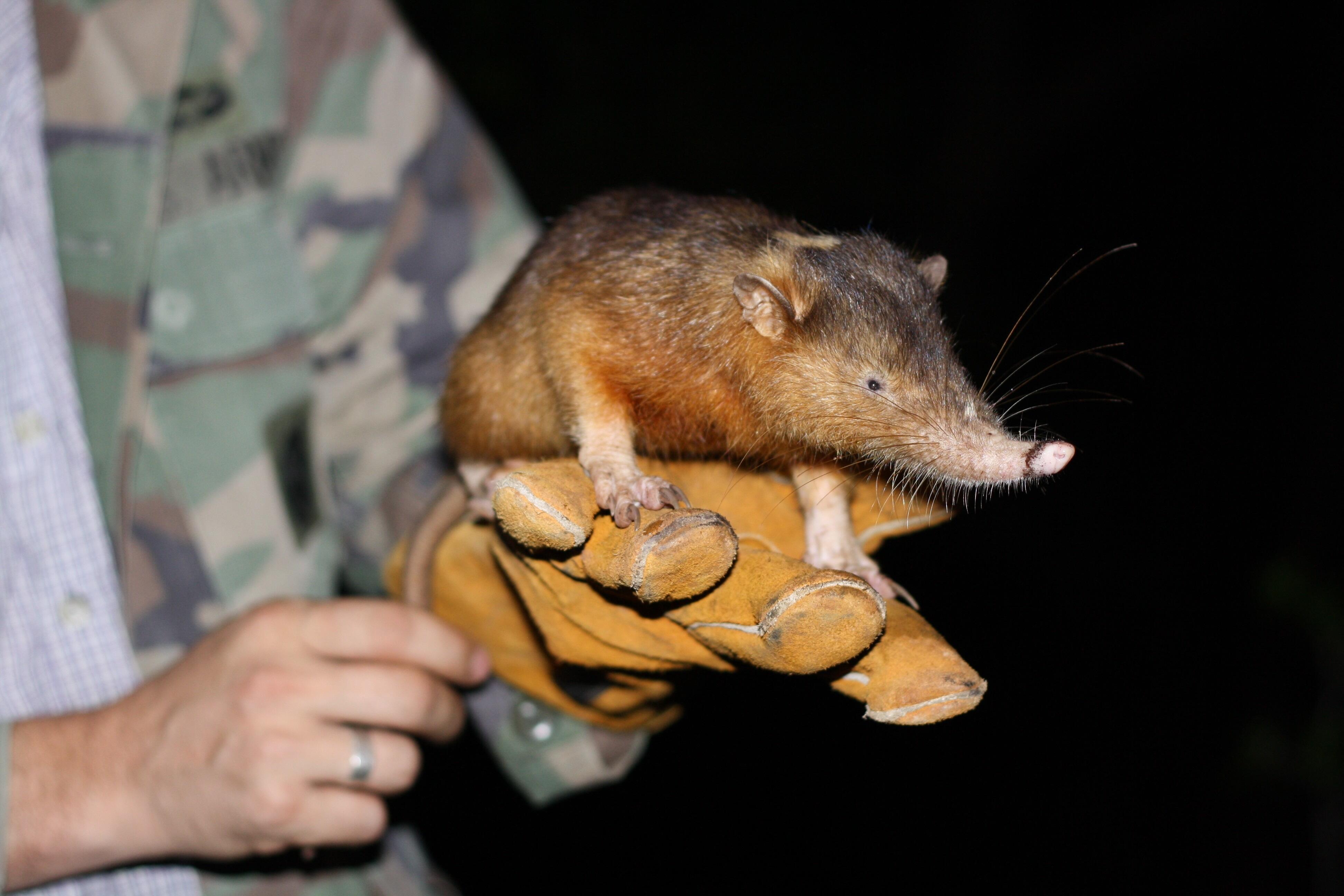
Highly similar venom toxins found in shrews and endangered Caribbean mammals, despite common ancestor over 70 million years ago
Researchers from Liverpool School of Tropical Medicine (LSTM) and Zoological Society of London (ZSL) have worked with a team of scientists from institutions across the globe – to uncover the truth behind the origin of venom in some very unusual mammals.
As outlined in a paper published today in PNAS, the team focused their attention on an unusual endangered species known as the Hispaniolan solenodon (Solenodon paradoxus) – a member of the eulipotyphlan order of mammals, an ancient group of insectivores also including hedgehogs, moles and shrews. Obtaining venom from wild solenodons and unravelling the genetic blueprint of this species enabled the identification of the proteins that make up their venom, revealing that it consists of multiple kallikrein-1 serine proteases. Analysis of these toxins showed they are probably used by solenodons to cause drops in blood pressure in the vertebrate prey on which they sometimes feed.
To their surprise, the team found that the kallikrein-1 serine protease toxins found in solenodon venom had evolved in parallel with those detected in the venom of distantly related venomous shrews. The same building blocks of venom have therefore evolved convergently within solenodons and shrews, despite their divergence from one another over 70 million years ago – when dinosaurs still walked the earth.
Professor Nick Casewell from LSTM’s Centre for Snakebite Research & Interventions (CSRI) is lead author on the paper. He said: “These particular proteins are present in the salivary glands of many mammals. Through our research we are able to demonstrate that they have been independently co-opted for a toxic role in the oral venom systems of both solenodons and shrews. These findings represent a fascinating example of how evolution can funnel novel adaptations down repeatable pathways”.
The Hispaniolan solenodon is only found on the Caribbean island of Hispaniola (made up of the Dominican Republic and Haiti), and is considered one of the most Evolutionarily Distinct and Globally Endangered (EDGE) mammals by ZSL’s EDGE of Existence programme. It is one of the few venomous mammals, producing toxic saliva that it injects into its prey through unique grooves in its lower incisor teeth, which gives the solenodon its name. Solenodons are some of the last few surviving Caribbean land mammals and are threatened today by habitat loss and predation from introduced dogs and cats.
Professor Samuel Turvey, from ZSL’s Institute of Zoology and who jointly led the project, said: “This study highlights how little we know about one of the world’s most fascinating animals. Unravelling details of the solenodon’s previously unstudied venom system helps us to understand the mechanisms behind convergent evolution - and demonstrates the importance of conserving the world’s remarkable EDGE species.”
Despite venoms being a rare trait in mammals, the team showed that venom has evolved independently on at least four occasions in eulipotyphlan mammals. This number of venom origins is more than those in all other groups of mammals combined, and more than for many other groups of vertebrates.
You can read the full article here: https://www.pnas.org/cgi/doi/10.1073/pnas.1906117116
See also an article on the topic in the New York Times, by clicking here
Solenodon genome reveals convergent evolution of venom in eulipotyphlan mammals
Nicholas R. Casewell, Laura-Oana Albulescu, Gareth Whiteley, Robert A. Harrison, Fiona M. S. Bolton - Liverpool School of Tropical Medicine; Alexis M. Mychajliw - Hokkaido University; David Richards, Neville M. Ngum, Ian R. Mellor- University of Nottingham; David Richards - University of East Anglia; Ivan Koludarov - Okinawa Institute of Science and Technology; Julien Slagboom, Jeroen Kool - Vrije Universiteit Amsterdam; Rosalind J. Kennerley - Durrell Wildlife Conservation Trust; Jorge L. Brocca -SOH Conservación; Jordan Debono, Bryan G. Fry - University of Queensland; Freek J. Vonk - Naturalis Biodiversity Center; Jessica Alföldi, Jeremy Johnson, Elinor K. Karlsson, Kerstin Lindblad-Toh - Broad Institute of MIT and Harvard; Daniel Petras, Benjamin-Florian Hempel, Roderich D. Süssmuth - Technische Universität Berlin; Elinor K. Karlsson - University of Massachusetts Medical School; Kerstin Lindblad-Toh - Uppsala University; Sanjaya Kuruppu, Wayne C. Hodgson- Monash University; Ian Barnes - Natural History Museum; Eivind A. B. Undheim - The University of Queensland; Eivind A. B. Undheim - University of Oslo; Samuel T. Turvey - Zoological Society of London; Daniel Petras- University of California, San Diego; Daren C. Card, Todd A. Castoe - University of Texas at Arlington; Daren C. Card - Harvard University; Vivek Suranse, Kartik Sunagar - Indian Institute of Science; Alexis M. Mychajliw- Stanford University; Alexis M. Mychajliw - Natural History Museum of Los Angeles County
ARTICLE #201906117
LSTM
Liverpool School of Tropical Medicine (LSTM) is the world's oldest centre of excellence in tropical medicine and international public health. It has been engaged in the fight against infectious, debilitating and disabling diseases since 1898 and continues that tradition today with a research portfolio over £320 million and a teaching programme attracting students from over 65 countries.
For further information please visit www.lstmed.ac.uk
ZSL
ZSL (Zoological Society of London) is an international conservation charity working to create a world where wildlife thrives. From investigating the health threats facing animals to helping people and wildlife live alongside each other, ZSL is committed to bringing wildlife back from the brink of extinction. Our work is realised through our ground-breaking science, our field conservation around the world and engaging millions of people through our two zoos, ZSL London Zoo and ZSL Whipsnade Zoo.
For more information, visit www.zsl.org